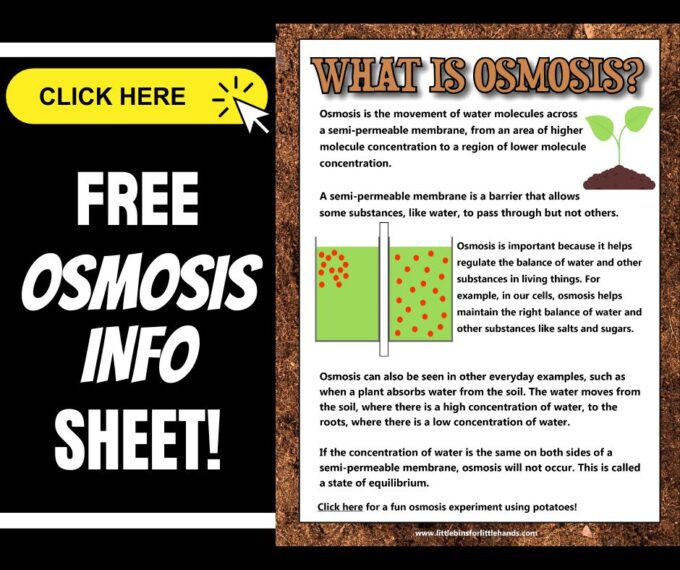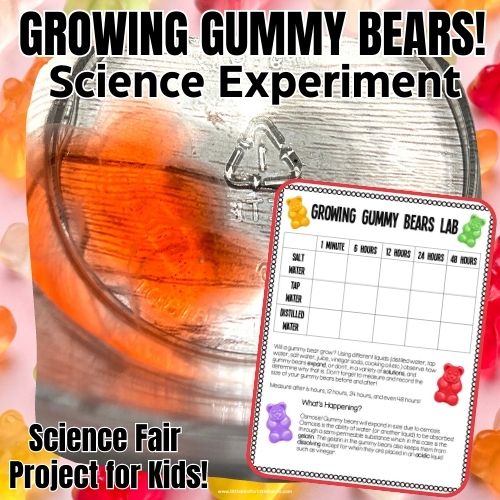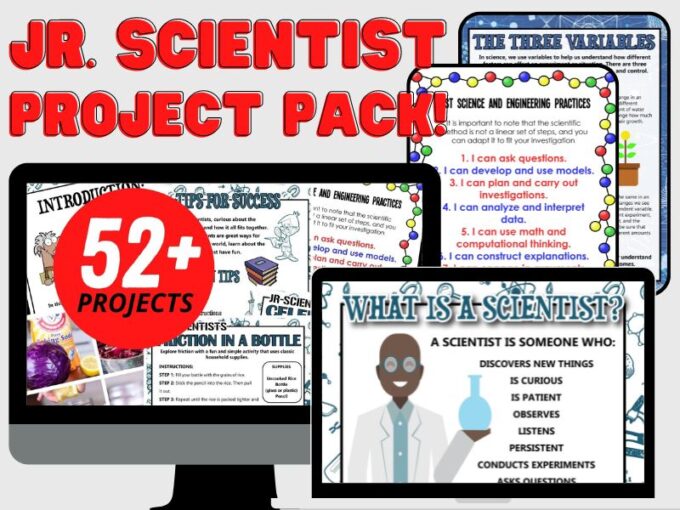What is osmosis for kids? Osmosis can be a tricky concept for kids to get their heads around. But here we have a simple osmosis definition and fun, hands-on osmosis science experiments kids will love! Watch gummy bears grow, experiment with potatoes, eggs and more. Easy science experiments for kids of all ages!
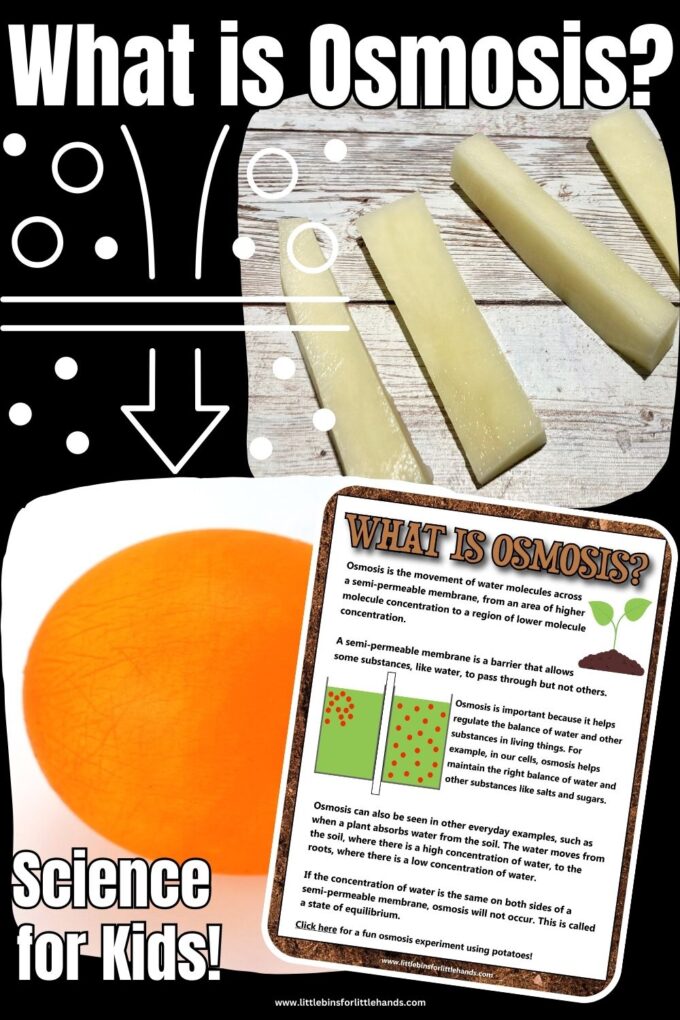
Easy Science Experiments For Kids
Science learning starts early, and you can be a part of that with setting up science at home with everyday materials. Or you can bring easy science experiments to a group of kids in the classroom!
We find a ton of value in cheap science activities and experiments. All our science experiments use inexpensive, everyday materials you can find at home or source from your local dollar store.
We even have a whole list of kitchen science experiments, using basic supplies you will have in your kitchen.
You can set up your science experiments as an activity focusing on exploration and discovery. Make sure to ask kids questions at each step, discuss what is happening and talk about the science behind it.
Alternatively, you can introduce the scientific method, get kids to record their observations, and make conclusions. Read more about the scientific method for kids to help you get started.
Osmosis Defined For Kids
Osmosis is the movement of water molecules across a semi-permeable membrane, from an area of higher molecular concentration to a region of lower molecular concentration.
A semi-permeable membrane is a barrier that allows some substances, like water, to pass through but not others.
Why Is Osmosis Important?
Osmosis is important because it helps regulate the balance of water and other substances in living things.
For example, in our cells, osmosis helps maintain the right balance of water and other substances like salts and sugars. Without the process of osmosis, cells would not survive.
Learn more about the structure of plant cells and animals cells.
Osmosis can also be seen in other everyday examples, such as when a plant absorbs water from the soil through its roots. The water moves from the soil, where there is a high concentration of water, to the cells in the roots, where there is a low concentration of water. Plants absorb mineral ions from the soil by active transport, against a concentration gradient.
If the concentration of water is the same on both sides of a semi-permeable membrane, osmosis will not occur. This is called a state of equilibrium.
Osmosis v Diffusion
Diffusion is also a physical process by which molecules move from a high concentration to a low concentration. Molecules, especially gases and liquids, tend to spread out to occupy all available space. Like osmosis, diffusion is a form of passive transport.
Think of someone spraying a fragrance into the air on one side of room. Before long, you can smell the molecules of the fragrance on the other side of the room. The fragrance has diffused throughout the room.
The difference between osmosis and diffusion is that osmosis is specifically the movement of water across a semi-permeable membrane. Osmosis and diffusion occur because of a concentration gradient, which is the difference in concentration of a substance between two areas.
Turn It Into A Science Fair Project
Science projects are an excellent tool for older kiddos to show what they know about science! Plus, they can be used in all sorts of environments including classrooms, homeschool, and groups.
Kids can take everything they have learned about using the scientific method, stating a hypothesis, choosing variables, and analyzing and presenting data.
Want to turn one of these osmosis experiments into an awesome science fair project? Check out these helpful resources.
Get Your Free Printable Osmosis Information Sheet!
Download this free osmosis information sheet and our Best Science Practices mini pack to start your own investigations with osmosis!
List Of Osmosis Experiments
Below you will find examples of osmosis experiments. All of these science experiments are quick to set up and easy to do at home or in the classroom.
Gummy Bear Experiment
Learn about the process of osmosis when you try this easy gummy bear osmosis experiment. Watch your gummy bears grow as you investigate which liquid makes them grow the biggest.
Candy Fish Experiment
Similar to our gummy bear experiment above, this time using candy fish. Investigate what happens when you add the gelatinous candy to a variety of liquids.
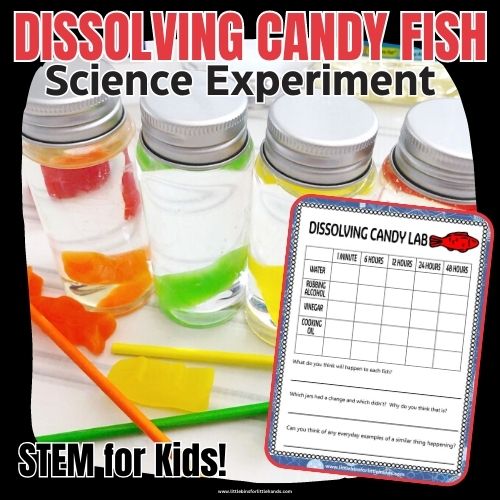
Egg Experiment
Here is a fun egg experiment that shows osmosis. First, you will need to dissolve the shell of a raw egg. See our naked egg experiment for how to do that. The egg membrane that remains is a good example of a semi-permeable membrane.
Dry and weigh your egg before placing it in a concentrated salt solution. Leave for at least 24 hours. Then dry and weigh your egg again. Use several shell-less eggs to compare different concentrations of salt solution.
Alternatively, you could create a concentrated sugar solution to test with different amounts of corn syrup.
Potato Osmosis Lab
Explore what happens to potato when you put them in concentration of salt water and then pure water. It is all to do with osmosis! You could also try this experiment with a carrot!
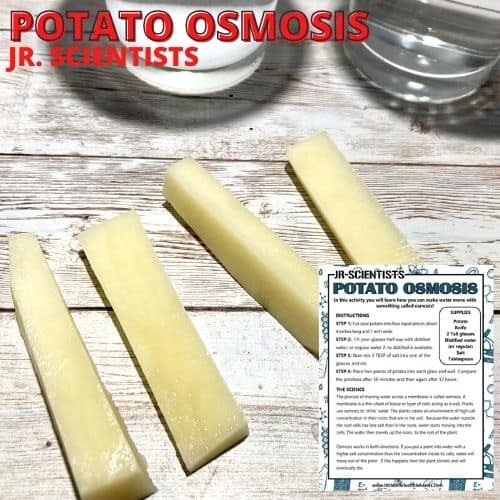
More Helpful Science Resources
Here are a few resources to help you introduce science more effectively to your kiddos or students and feel confident when presenting materials. You’ll find helpful free printables throughout.
- Best Science Practices (as it relates to the scientific method)
- Science Vocabulary
- 8 Science Books for Kids
- What Is A Scientist
- Science Supplies List
- Science Tools for Kids
52 Printable Science Projects For Kids
If you’re looking to grab all of the printable science projects in one convenient place plus exclusive worksheets, our Science Project Pack is what you need!


